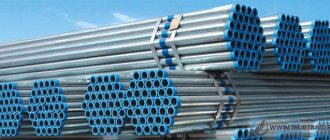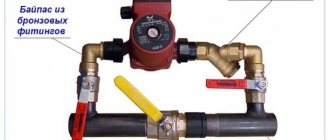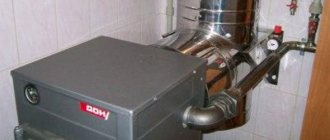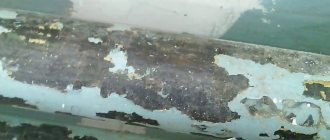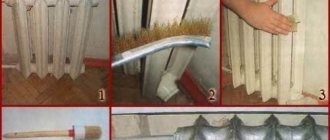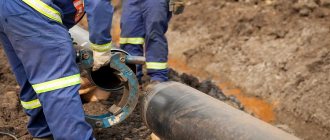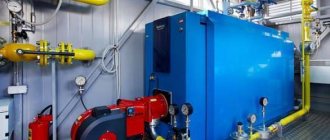Michel
10361 0 2
Michel July 30, 2016Specialization: plumber with 10 years of experience, computer repair specialist, powerlifting coach. I have extensive experience in construction, interior decoration, and making homemade furniture. Hobbies: sports
Painting pipes is a process that requires a preliminary search for answers to some questions. In particular, an important point will be the need to understand the choice of paint, because the paint for pipes in the bathroom differs from the compositions for heating system communications. In addition, it is necessary to thoroughly prepare the surface, and you should also consider whether there is a need to remove the previous layer of coloring composition.
Rusty pipes spoil the overall aesthetics of the home.
Which paint to choose for heating pipes - possible options, characteristics
The heating system is an integral part of any modern living space.
Therefore, the question of its safety and protection from corrosive processes is relevant, as is its aesthetic appearance. The solution to the above problems lies not only in the technology of painting work, but also in the choice of materials. There are many offers in the field of paint and varnish materials on the construction market, which sometimes confuses not only those who have decided to decorate their home on their own, but also those who are professionally engaged in painting work. What paint to paint heating pipes in order to guarantee a high-quality result depends on some nuances.

Before painting heating pipes and radiator batteries, you need to know what functionality the coating will perform. The primary task is to protect the metal product from corrosion. Also, recently the decorative appearance has become of no small importance. Not only metal, but also plastic (polypropylene) pipes of heating and water supply systems are painted.
Oil-based coloring compounds are already a thing of the past. There are an assortment of high-quality analogues on store shelves. Products should have the following advantages:
- Resistant to high temperatures. If the composition is not resistant to elevated temperature influences, when the heating system is turned on, the entire coating will be covered with a network of cracks, because the pipes will heat up;
- Anti-corrosion effect. The composition must prevent corrosion. Thus, the heating pipes will serve you for a very long time, remaining in perfect condition;
- The coloring composition should not change its color.
The choice of paint for heating pipes is limited to three options: water-dispersion compositions, alkyd and acrylic enamels made on the basis of organic solvents. Let's look at the advantages and disadvantages of each option:
Alkyd compositions
Advantages
Possibility of applying a uniform layer, wear resistance, abrasion resistance, strength, can be used at high temperatures.
Flaws
Painting work and the time it takes for the composition to dry are accompanied by a rather unpleasant odor.
Acrylic enamels based on organic solvents
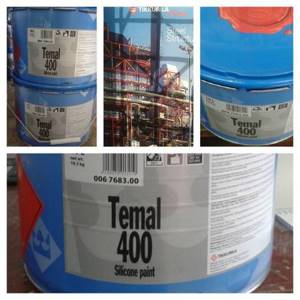
The acrylic enamels coating has a pleasant glossy shine; the composition does not change its original color throughout the entire period of operation.
The disadvantage is similar to the first option: painting work is accompanied by a rather unpleasant odor;
Water-dispersed compositions
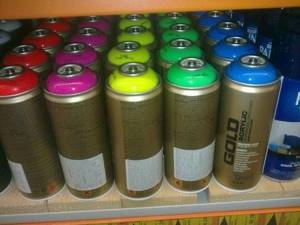
Ideal for coating heating pipes and radiators. They are free from the main drawback of the first two options: they do not emit unpleasant odors during operation and when drying.
How to paint heating pipes correctly?
It is recommended to paint the pipeline only when it is in a cold state. To do this, you can simply turn off the heating system for a while. Or you can carry out work in the summer. Why can't you paint hot heating pipes? First of all, it's just very inconvenient. Secondly, the layer will most likely be uneven. Thirdly, the coating may crack during drying, making re-work necessary.
So, let's get down to recommendations for carrying out the work. The paint is applied evenly to the pipes using a brush and spray gun. The inner surface of the pipeline can be painted with a regular brush. Make sure there are no blind areas. We begin the work from the top. After applying the first layer, let it dry thoroughly. Then apply the second layer. Two layers will provide uniform and aesthetic coverage. Also make sure that there are no smudges. Immediately smear them with a brush or remove them with a cloth.
Don't forget the base!
The quality and durability of the coating depends not only on the paint, but also on a good primer composition. If your pipes are made of metal, it is better to use an alkyd-based primer.
We recommend that you purchase primers with an anti-corrosion effect. Thus, you will be able to maintain the aesthetic appearance of the pipeline for a long time. In a construction supermarket you can buy “two in one”: primer paint compositions. You can also find three-in-one products: primer paint products that contain a rust converter, which allows you to apply paint to an uncleaned surface.
It’s easy to buy paint these days. In construction stores you can find products for every taste and color.
Why do you need to paint pipes?
Before calculating the amount of paint and getting acquainted with the sequence of actions, let's look at why you need to paint pipes.
The main reason is protection against corrosion. No matter how much you would like to use metal-plastic in plumbing work, steel pipes will be used in everyday life for a long time. In the last century they were used everywhere, but the disadvantage of using them was the lack of anti-corrosion coatings.
Paint is primarily protection against corrosion
Thus, water pipes, already unreliable, began to disintegrate; it would be a different matter if paint for hot water supply pipes had been used for this, but even this would have saved them for only 5 years. Nowadays, in many apartments and private houses, engineering systems are made of steel, so it is better to replace them if necessary.
Advice: galvanized pipes do not require painting to protect them from rust; threads are another matter, where the top layer is easily damaged. To correct this situation, you need paint for galvanized iron, which will extend the service life of the water supply system.
Preparatory work before painting heating pipes
As mentioned earlier, before painting heating pipes, you should carefully prepare the surface for such work.
The entire procedure should follow the following instructions:
- First of all, you should clean the surface of the pipe by removing the remnants of old paint from it using a spatula and a special solution and cleaning the areas with rust to a shine. After this, use a wet cloth to remove dust and dirt.
- Next, the rinsing solution must be applied to the pipe and covered with a film so that it softens. After some time, removing the remaining paint will not be difficult either with a spatula or a drill equipped with a special metal brush.
- Then the surface of the pipe should be treated with sandpaper and degreased with an alcohol solution.
- After this, a primer is applied to the pipe, the main function of which is to protect against corrosion. In addition, this composition also increases adhesive properties, improving the bond of the coloring composition with the metal pipe. In this case, it is best to use an alkyd-based primer.
Preparing for painting
The quality of painting radiators depends on how well you prepared them for this operation. Often the preparatory stage takes longer than the painting itself, but knowing how to remove paint from a heating pipe using special means can speed it up a little. Preparation for applying the coloring composition is as follows:
- Removing dust and dirt with a wet cloth.
- Removing old layers: apply a solution to wash it off on the pipe and cover it with film. Remove it using a spatula, a wire brush attached to a drill, or a grinder. It is advisable to protect your nose and mouth with a respirator or gauze bandage, and your hands with gloves.
- Sanding the surface with sandpaper, cleaning places where there is rust until the metal shines.
- Degreasing with white spirit or some slightly alkaline solution.
- Applying an anti-corrosion primer to a cleaned surface to help the paint adhere better and prevent rust. A primer with an alkyd base is best.
The durability and quality of the coating also depends on a good primer. Therefore, choose one that states that it has anti-corrosion properties, otherwise rust will reappear over time.
If the heating pipes in your apartment are metal, use an alkyd-based primer. On a surface that has been prepared taking into account all requirements.
Now many manufacturers produce paints that already contain a primer, as well as a rust converter. If you wish, you can buy such a composition and not waste time applying the foundation.
Requirements for heating systems
In order not to make a mistake about what paint to paint heating pipes with, you need to know the requirements that it must meet. After all, the heating system is usually exposed to fairly high temperatures and temperature changes. In addition to internal conditions, there are also external influencing factors. Therefore, the main characteristics should be as follows:
- resistance to high temperatures - it should not crack or deform;
- anti-corrosion effect: high-quality protection against rust;
- non-toxic: no harmful substances should be released into the air when the paint is heated;
- resistance to high humidity, aggressive environments and mechanical damage;
- high strength of the coating: it should not peel off from the pipe;
- maintaining the original texture and color over time.
It is necessary to choose a paint designed specifically for painting metal products. Although it will cost more, such a coating that meets the specified conditions will ensure a long service life.
Basic requirements for paint and varnish compositions
During operation, the paint layer should not crack, change its original shade, or emit any odors when heated. It is important that paints and varnishes are designed to work with metal products, otherwise the ingredients will cause corrosion and destruction of the metal.
Radiators and pipes require periodic cleaning, during which abrasive detergents and brushes are essential. Good paints can withstand cleaning without losing their original appearance, do not turn yellow or wear out. In order not to make a mistake in choosing a product, it is recommended to purchase products designed to work with radiators and heating pipes. Manufacturers inform on the packaging that they belong to this group of paints and varnishes.
Instructions for painting pipes
In order for the result to be pleasing and the painting work not to have to be redone, spending extra money and time, it is necessary to adhere to the technology and follow the recommendations of specialists. The quality of preliminary surface preparation often has a greater impact on the durability and aesthetics of the coating than the choice of paint.
Preparatory work
First of all, you need to take care of protecting the floor, walls and surrounding objects. Old newspapers, magazines, oilcloth or construction film are suitable for this. No matter how hard you try to do everything carefully, paint can still drip or splash in the most inappropriate place. Therefore, it is better to play it safe so as not to think later than to remove paint stains.
On a note! Personal protective equipment will be useful for work: gloves, a hat, work clothes that you don’t mind getting dirty. If you use paint with a smell, you will also need a respirator.
Before painting, the surface of the pipes must be cleaned of dust, dirt and old paint. If the previously applied layers of paint are thin enough, adhere well and do not crack, then you can leave them and just get by with sanding them with sandpaper. Areas with rust need to be treated especially carefully. White spirit or any slightly alkaline solution works well for degreasing the surface.
The best water-based paints for radiators
Acrylic paint for heating radiators Radiator Festek
The products are offered by a Ukrainian manufacturer. The type of composition is one-component, but it guarantees increased resistance to the adverse effects of water. Allows you to improve the external condition of heating radiators thanks to a pleasant matte snow-white shade.
- absence of any odors;
- increased resistance to water washing and dry abrasion;
- the ability to completely paint heating batteries without further influence of external factors;
- resistance to yellowing;
- the ability to withstand heating up to 95 degrees Celsius;
- minimal drying time, which speeds up the procedure.
Washable odorless semi-matte paint Remontti Assa Tikkurila
These paint and varnish products are offered by a well-known Finnish manufacturer, which takes into account current standards and successfully produces high-quality modern paints for the further processing of heating batteries.
The composition is created using an acrylate binder. At the same time, the manufacturer refused to use organic solvents. This approach to the creation of paint and varnish products contributed to the receipt of the “Eco-label” of the European Union. The Association of Allergy and Asthmatic Disease Specialists of Finland participated in the development, as a result of which the products are completely safe even for allergy sufferers and asthmatics.
- created from high-quality components and modern technologies;
- high level of safety, due to which the use of products is justified in most cases;
- resistance to washing and abrasion.
Acrylic enamel for heating radiators Farbex Polisan
The products are offered by the famous Ukrainian manufacturer Polisan, which tries to take into account current standards and offer only high-quality paints and varnishes. It is assumed that it is possible to carry out decorative and protective painting of heating devices.
- requires minimal time to dry;
- It has a snow-white hue and a pleasant glossy finish, and the original color remains for a long time;
- optimal adhesion to various types of surfaces is guaranteed;
- there is increased resistance to frequent repeated washing;
- additional treatment with pigment concentrates is available, as a result of which the heating device can fit perfectly into the design of the room;
- no pungent odor;
- The content of volatile organic compounds complies with current standards, therefore the products are recognized as safe.
- the radiator must be thoroughly treated before further painting, and dust, rust, scale, grease and other contaminants must be excluded;
- surfaces that were previously painted with alkyd or oil paint must be carefully treated until matte and degreased;
- preparing paint requires a careful approach and effort, strict adherence to the instructions and certain room conditions (air humidity should not be lower than 80%, and the surface temperature should be from +10 degrees).
- Correct use of paint justifies its choice for further use and successful treatment of used heating radiators.
Paint for radiators Balakryl Radet
The Czech brand Balakryl offers high-quality paint that is ideal for treating heating radiators in modern heating systems of residential and industrial premises.
- increased resistance to the adverse effects of water;
- possibility of use in rooms where there is a high level of humidity;
- The heat resistance exceeds 100 degrees, therefore the safety and long-term preservation of the original condition of the heating batteries is guaranteed.
Selection of coloring compositions
The selection of dyes is carried out taking into account the following requirements:
- Location of the object. For street communications, compounds will be selected that are resistant to temperature changes and have high protective qualities. In residential areas, you should give preference to environmentally friendly acrylic enamels.
- Type of material: for metal or for polymer structures. Each base will require a different type of paint.
- Temperature effects. If you plan to paint heating pipes, then you should choose heat-resistant compounds, while for sewerage inside the building, the paint should only be water-resistant.
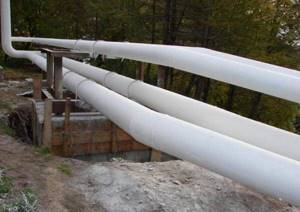
By choosing a composition taking into account these requirements, long-lasting protection of communication systems can be ensured.
Types of paints for batteries
Today, many manufacturing companies offer a fairly wide range of products such as odorless paint for radiators. Thanks to this, buyers have the opportunity to choose the most suitable type for themselves:
- Acrylic enamel;
- Alkyd enamel;
- Oil enamel;
- Water based.
All types differ from each other in production technology, composition and characteristics.
Acrylic enamel
Acrylic paints:
- have no characteristic odor and are excellent for interior work.
- Their widespread use in everyday life is also due to the fact that they dry quickly enough,
- are characterized by increased moisture resistance,
- uniform application on any surface,
- and are also absolutely safe for people.
- Due to the fact that the substance contains special additives, the paint layer does not begin to crack and turn yellow when the temperature of the radiator or battery increases.
- In addition, it should be noted that manufacturers offer a huge range of colors, so acrylic paint for heating radiators is often used in the artistic design of surfaces.
As for the disadvantages, the most significant of them is the high cost. However, it fully corresponds to the good performance qualities of the paint.
Alkyd enamel
Alkyd paints, manufactured using the latest technologies, have the following advantages:
- A surface coated with a layer of such a substance is resistant to elevated temperatures - it does not crack when heated to 120C;
- High strength;
- Homogeneous layer structure during application;
- Good resistance to abrasion when operating radiators and radiators;
- A wide range of colors allows you to choose almost any color;
- The layer maintains its integrity for a long time.
However, in addition to the advantages, there is also a disadvantage - for several days after painting, an unpleasant odor persists, which may subsequently appear if the heating is strong enough. In addition, some brands sometimes fade a little and may also change shade.
Water based enamel
Odorless, water-dispersion paint for hot radiators is an excellent option for coating radiators. It differs from other types in a number of features:
- It is made from ordinary water, so it is absolutely safe for people and the environment;
- Special dispersed particles are not harmful;
- There is no unpleasant odor;
- It takes very little time to dry completely;
- Apply easily and evenly;
- Thanks to the water-repellent effect, painted batteries can be washed without destroying the layer;
- Suitable for use in a wide variety of spaces.
The disadvantage is that the color range is not very diverse, because it is mostly only white.
Oil enamel
Oil products are in quite high demand due to a number of their advantages:
- No sharp and unpleasant odor after application and further heating of batteries and radiators;
- They are divided into colored and colorless;
- Easy to apply to metal surfaces;
- Form a uniform layer;
- Excellent for use inside both residential and non-residential premises;
- Low cost compared to other types of battery paints;
- Can be used for artistic decoration of surfaces - applying patterns and complex designs.
The downside is that it takes a very long time to dry completely. This is due to the fact that a solvent is added to the paint.
Selection of paints and varnishes
Oil-based products are not suitable for painting pipes and risers. They take a long time to dry, have an unpleasant odor, and also fade over time. The paint composition must contain a corrosion inhibitor.
The following types of paints are suitable for heating iron pipes:
- Alkyd enamels. These are common formulations that have a low cost. They have an unpleasant odor when the pipes are heated and may fade over time. Dries in 24 hours.
- Acrylic enamels. The composition contains organic solvents, which is why there is a slight specific odor. They have a wide color palette of glossy and matte shades and dry in one hour. Before applying them, it may be necessary to prime the metal surface of the pipe. The brightness of the color is maintained throughout the entire period of operation.
- Water-dispersed compositions. These are the safest types of paints. They have a long service life and brightness of the coating. They dry quickly and have no odor.
Popular brands include Heitzkorperlak, Mipaterm 600, GF-0119 enamel, UNIPOL primer-enamel.
The choice of color depends only on the design of the apartment and room, as well as the preferences of the owners. There are paints for silver, bronze, copper, as well as products with the ability to apply patterns. Dark paints have the best heat transfer.
The amount of paint depends on the consumption per linear meter. This value is multiplied by the area of the pipe surface to be painted, and a margin is also added. The estimate is calculated in advance.
Painting process and technology: calculation of paint consumption rates
In order to begin the painting process, you need to calculate the paint for the pipes. To implement it, you need to know the length and diameter of the product that requires a color change.
The technology for painting pipes is simple and accessible to everyone
Important! Almost all manufacturers of paints and varnishes write on the label the approximate consumption of space per area.
Let's roughly calculate the paint consumption for pipes 10 meters long. To do this, take a jar of 500 grams of enamel, apply one layer to a 10-meter pipe with a thickness of 2 centimeters. So, since you need at least 2 layers, then the paint will be enough. Calculation of the amount of paint for pipes should be as accurate as possible.
Advice: do the calculations correctly so as not to run to the store several times. In addition, you will provide yourself with the amount of material that you need, and there will be enough for painting. Otherwise, if the paint consumption is not correct, you will not buy as much as you need, and the store may not have any left.
Technology for painting steel (metal) gas pipes and communications for heating and sewerage
To ensure that the paint on galvanized pipes for cold water supply is of high quality, follow the sequence of actions. The technology for painting a pipeline is not complicated in principle.
First, dry the pipe. What is needed for this:
- Fill the container with the amount of water you use over a period of 24 hours.
- Do not turn on taps with cold water, so it reaches the same temperature as in the room, and the moisture does not evaporate.
If you need to paint the galvanized riser with cold water, use a fan to do this, which, using a strong air flow, pushes all the moisture out of the pipe and dries it.
Next steps:
- Surface preparation. Take a metal brush and remove any remaining paint and rust from the surface. If you don't have a brush, a knife will do. In the case when the old enamel is difficult to remove, heat it with a gas burner, then the process will go faster;
- Surface cleaning;
- Primer. This procedure protects the water supply from corrosion and makes painting quick and easy;
- Painting. For this stage you will need zinc metal paint, which must be applied in two thin layers. In the case of a very thick liquid, dilute it with solvents in a small amount, because thick paint takes twice as long to dry, and unnecessary lumps and stains form.
To paint plumbing systems through which hot liquid flows, use paints that indicate the appropriate temperature. Take a brush and apply a thin layer of paint; it will dry instantly. You can also use a spray gun, which will simplify your work.
We hope the article was useful to you and helped you in solving an important problem. Paint for pipes must have the qualities of maximum protection against moisture on the external walls.
trubexpert.ru
When carrying out communications, it is important to protect them from external influences and corrosion. A specialist can advise which paint is best for painting cold water pipes, heating systems and hot water supply. Previously, oil compositions that were not of high quality were used for these purposes. Modern mixtures are odorless, dry quickly, perform their functions well and provide an element of aesthetics, giving the pipelines in the house a decent appearance.
Description of types of enamels
When heating rooms, a medium is used whose temperature can reach 100°C. In this regard, special requirements are imposed on paint for heating pipes:
- The ability not to lose color.
- High level of coating strength.
- The enamel should be odorless.
- Resistance to temperature changes.
- Safety.
- Immunity to aggressive substances and mechanical damage.
- Anti-corrosion ability.
There are several types of enamel for pipelines. When using a glossy solution on uneven surfaces, all imperfections will be visible. When applied matte type, defects are invisible, but over time they turn gray as dust gets clogged into the pores. To choose the appropriate composition, it is important to know about the properties and features of different products:
1. Acrylic.
It is durable and has a beautiful shine. Once dry it looks like plastic. The water-based substance is easy to use, practically odorless, but does not contain anti-corrosion additives. Another option - acrylic paint for hot heating pipes is suitable for processing any metal: stainless, low-carbon, galvanized, aluminum alloys. Drying time between layers is 30 minutes, complete hardening is 2 hours. Does not lose its properties at heating temperatures up to 150°C.
The disadvantage is that the enamel cannot be applied when the coolant is hot. Please note that it may change color after drying. During work, it is necessary to use a respirator, since the smell of acrylic paint persists for some time, but disappears quickly enough and is not present when the pipeline is heated. According to customer reviews, the glossy shine lasts a long time.
The most famous manufacturer is the German company Dufa. Their compositions are made on the basis of synthetic resins. Contains 100% acrylic. Dulux enamels are offered by AzkoNobel. The advantage of the product is a large number of anti-corrosion impurities; you can choose any shade. If the apartment owner prefers to buy white, the preservation of the tone will be ensured.
2. Alkyd paints.
The products can withstand high temperatures well and are applied to hot pipes. This is convenient for houses where urgent repairs are required, and turning off the heating is impossible. Like acrylic paint, alkyd enamel has an unpleasant odor that persists until it dries. Compositions come on different bases. With a component of organic solvents, the mixture gives a glossy surface.
A matte shade is obtained when using paint with silicone additives. They are heat-resistant, can withstand temperatures up to 600°C, and are intended for hot shops and production facilities. Available in aerosol cans. Water-based enamel is suitable for metal and is heat resistant. To prevent the paint from turning yellow later, it is recommended to choose a type with titanium or blue pigment. Its cost is a little more expensive, but it is worth buying due to its durability and preservation of properties.
Manufacturer Tikkurila offers products with a semi-matte sheen based on white spirit. The time interval between layers is 24 hours. The enamel is resistant to turpentine and denatured alcohol, and does not tolerate nitro solvents. Application conditions: air humidity not higher than 80%.
3. Odorless compositions.
The solution is a water-dispersed acrylic paint, which does not release chemicals when working with it. It dries quickly and is suitable for special temperature conditions, which makes it possible to choose heating system pipes for processing. To prevent the enamel from turning yellow, it must contain a silver pigment. The advantages include ease of maintenance during operation: just wipe with a sponge and soapy water.
The review of manufacturers presents such well-known companies as Dulux and Belinka, offering heat-resistant anti-corrosion products. No primer is required for these enamels, they create a perfect matte surface in white, steel and gray shades. They have good adhesion properties and the ability to retain color throughout their entire service life.
obogrevguru.ru
Features of paints for working on rust
In order for rust paint to provide maximum anti-corrosion protection, manufacturers use a combined approach, trying to combine the properties of conventional paints with the properties of a protective primer and a rust converter.
Because of this, the range of such paints is very diverse and every day it is replenished with new names. The same can be said about their recipe.
Rust paints can be very roughly classified according to the following criteria:
- What main type of paint are they based on?
- For what purposes are they intended?
- What temperature conditions are they designed for?
- What are the main components included in their composition?
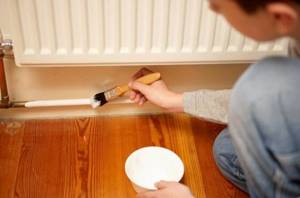
Painting a metal pipe
It is not surprising that it is not easy to classify rust paint as a specific type. Each description represents a combination of different performance characteristics.
This can be illustrated using the example of one of the most popular groups of dyes – hammer dyes.
Step-by-step instruction
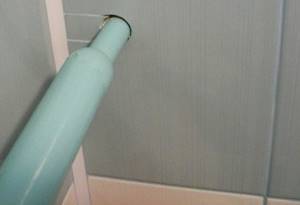
It is necessary to choose the right paint and primer.
If the pipe is metal, then you will need the following set of tools and materials:
- Tools that can be used to clean pipes from old paint and rust (grinder with cleaning disc, metal brush, sharp spatula, sandpaper).
- Rust conversion products.
- Flute brush, roller.
- Cuvette.
- Primer.
- Dye.
- Rags for wiping, materials for protecting floors and walls from accidental paint.
- Gloves.
The procedure is as follows:
- We close the walls and floor around the pipe.
- We clean the pipe from the old coating.
- We treat areas with traces of rust: remove rust with a stiff brush, sand with sandpaper, and treat with a rust converter.
- Carefully wipe the pipe with a damp cloth to remove dust, then wipe it dry.
- Apply primer.
- After the primer has dried, you can paint it. It is better to use a roller, using a brush in hard-to-reach places.
- After the first layer has dried, you can apply the second.
How to remove old grout from tile joints
with your own hands?
Find out in this article how to cover the pipes in the bathroom with plasterboard with your own hands.
As already mentioned, it is advisable to paint pipes when they are cold. But what to do with an old-style metal heated towel rail in the bathroom? After all, it is cold only during the period when hot water is turned off in the entire house.
Experienced people recommend the following: if the paint on a hot surface has dried too quickly and the layer is uneven, you can sand the surface and apply a 2nd coat of paint. In this way it is quite possible to achieve a good result.
Plastic pipes can be painted without a primer, but you will still have to remove the old paint. This is best done using a solvent that does not contain acetone. After washing and drying, the pipe can be painted.
As you can see, painting the pipes in the bathroom yourself is not at all difficult. Everything you need is available for sale: paints, primers and other materials. The main thing is to choose the right one and treat the painting process carefully and carefully.
Source

